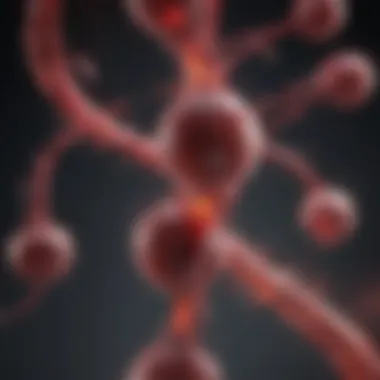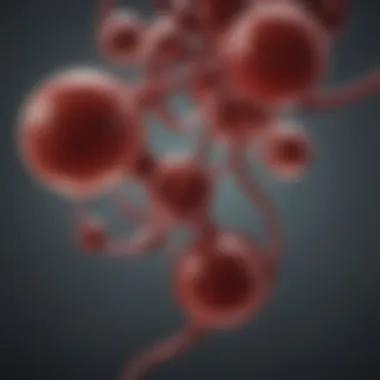Sickle Cell Disease and Iron Deficiency Explained


Intro
Sickle cell disease and iron deficiency, while distinct health issues, often overlap in their presentation and management. Understanding how these conditions interact is paramount for healthcare professionals, educators, and researchers. A comprehensive exploration of this intersection can illuminate the necessary approaches for proper diagnosis and tailored treatment options.
Iron deficiency impacts various physiological processes, particularly the production of hemoglobin, which is crucial for carrying oxygen in the blood. Equally, sickle cell disease, an inherited blood disorder, leads to the production of abnormal hemoglobin, which can result in various complications, including anemia. When these two conditions coexist, the challenges faced by patients can multiply.
In this article, we aim to unpack the biological mechanisms linking sickle cell disease and iron deficiency. We will examine how these conditions can exacerbate each other and what strategies are available for effective management. More than just a discussion of symptoms and treatments, this article seeks to enhance the understanding of the complex interplay between these health concerns, ensuring that clinical practices reflect the latest research and insights.
Methodologies
Description of Research Techniques
In investigating the connection between sickle cell disease and iron deficiency, various research techniques are employed. These include:
- Cross-sectional studies: This method allows researchers to observe the prevalence of iron deficiency in patients with sickle cell disease at a specific point in time. By analyzing blood samples, researchers can measure key indicators such as hemoglobin levels and ferritin concentrations.
- Longitudinal studies: Following patients over time provides insights into how the relationship between sickle cell disease and iron deficiency may evolve. These studies can identify trends in iron status and how they correlate with disease progression.
- Clinical trials: Trials that explore different treatment modalities, such as iron supplementation or blood transfusions, are essential for understanding their efficacy in improving outcomes for patients with concurrent conditions.
Tools and Technologies Used
The advancements in medical science have introduced various tools and technologies that aid in research. These include:
- Immunoassays: Useful for measuring specific proteins like ferritin, which indicate iron levels in the body, these assays provide crucial data for diagnosing iron deficiency.
- Genetic testing: Understanding the genetic underpinnings of sickle cell disease can help tailor treatments to individuals, especially those with multiple health challenges.
- Magnetic Resonance Imaging (MRI): MRI techniques can visualize iron overload in the organs, particularly the liver and heart, which is crucial in patients who may require blood transfusions.
Discussion
Comparison with Previous Research
Numerous studies have documented the individual effects of sickle cell disease and iron deficiency. However, more recent research sheds light on their coexistence and the compounded effects. For instance, findings indicate that iron deficiency can worsen the anemia already present in sickle cell disease, creating a spiraling effect on patient health and quality of life.
Theoretical Implications
The intersection of sickle cell disease and iron deficiency raises fundamental questions about the underlying pathophysiology. It brings forth the need for advanced understanding in hematology and related fields. Theories suggest that chronic inflammation, common in sickle cell disease, can lead to functional iron deficiency, complicating the clinical picture.
To conclude, addressing these conditions in conjunction brings about a vital opportunity for improved patient care. Armed with the knowledge of their relationship, healthcare providers can pursue more effective management strategies.
Understanding Sickle Cell Disease
Sickle cell disease is a significant public health issue that affects millions globally. Understanding this condition is paramount, especially when it comes to its intricate relationship with iron deficiency. By defining what sickle cell disease is and its underpinnings, healthcare professionals and researchers can better navigate the complexities that surround the management of patients suffering from both this disease and iron deficiency. This exploration will not only enhance clinical outcomes but also improve the quality of life for the patients afflicted.
Defining Sickle Cell Disease
Sickle cell disease is a genetic disorder that affects the structure and function of hemoglobin, which is crucial for transporting oxygen throughout the body. Instead of having the typical round shape, red blood cells in individuals with this disease become rigid and shaped like a sickle or crescent moon. This abnormality leads to issues in blood flow, increasing the likelihood of blockages in small blood vessels, which in turn results in significant pain episodes known as sickle cell crises.
Genetics of Sickle Cell Anemia
At its core, sickle cell anemia is inherited in an autosomal recessive fashion. This means that for a child to be affected, they must inherit two copies of the mutated gene, one from each parent. The mutation occurs in the HBB gene, which is responsible for coding the beta-globin subunit of hemoglobin. It’s not uncommon for individuals with one copy of the mutated gene (carriers known as sickle cell trait) to be asymptomatic, though they can pass the trait onto their offspring. This genetic component plays a significant role in understanding how sickle cell disease manifests and what potential interventions may be necessary throughout a patient's life.


Pathophysiology of Sickle Cell Disease
The pathophysiology behind sickle cell disease is multifaceted. The polymerization of deoxygenated sickle hemoglobin (HbS) leads to red blood cell deformation, causing these cells to lose their flexibility. This rigidity results in pain, due to the inability of the blood to flow smoothly through the vessels. Moreover, repeated sickling can lead to hemolytic anemia, where the lifespan of these abnormal cells is significantly reduced, leading to chronic fatigue and an increase in erythropoiesis—where the bone marrow attempts to produce new erythrocytes to compensate.
Clinical Presentation and Symptoms
Symptoms of sickle cell disease can vary widely among individuals. Common presentations include:
- Severe pain in the abdomen, chest, joints, or bones
- Fatigue and weakness due to anemia
- Frequent infections caused by splenic dysfunction
- Episodes of jaundice resulting from the destruction of red blood cells
The array of symptoms makes diagnosis tricky since they can mimic other conditions. It is crucial for clinicians to be vigilant and conduct thorough evaluations.
Complications Associated with Sickle Cell Disease
The complications stemming from sickle cell disease are numerous and can become severe over time. Some of the most notable include:
- Acute chest syndrome: This is a life-threatening complication characterized by chest pain, fever, and respiratory symptoms.
- Stroke: Sickle cells can cause blockages in the brain's blood supply.
- Organ damage: Consistent lack of oxygen leads to chronic damage in organs such as the kidneys and liver.
- Leg ulcers: Chronic painful sores can develop due to poor circulation.
In summary, a thorough understanding of sickle cell disease is foundational in addressing the intersection of this condition with iron deficiency. The complexities and challenges presented by sickle cell disease necessitate comprehensive management strategies that consider all aspects of the patient's health.
Iron Deficiency: An Overview
Iron deficiency represents a significant global health issue, affecting a broad spectrum of populations, particularly vulnerable groups such as children and women of reproductive age. Understanding the framework surrounding iron deficiency is vital for grasping its implications in patients with sickle cell disease, where the presence of dual conditions can complicate management strategies. The links between iron metabolism, hemoglobin function, and overall health illustrate why iron deficiency warrants a detailed examination within this context.
Defining Iron Deficiency
Iron deficiency refers to a state where the body's iron stores are depleted, adversely affecting the production of hemoglobin. This condition can lead to anemia, affecting the delivery of oxygen to tissues, a vital process for sustaining life. In the case of chronic blood disorders, like sickle cell disease, the consequences of iron deficiency can be even more pronounced. It’s not merely an issue of iron levels, but rather a multifaceted health concern that can escalate the challenges faced by affected individuals.
Epidemiology of Iron Deficiency
Globally, iron deficiency is estimated to affect approximately 1.62 billion people, making it the most prevalent nutritional deficiency. According to the World Health Organization, it is a considerable contributor to the burden of disease across many regions, particularly in developing nations. Certain risk factors can elevate the likelihood of iron deficiency, such as dietary insufficiencies, malabsorption disorders, and chronic diseases that demand increased physiological iron requirements.
Causes of Iron Deficiency
Iron deficiency can stem from various origins:
- Dietary Issues: Insufficient intake of iron-rich foods, such as red meat, legumes, and fortified cereals, is a leading cause.
- Absorption Problems: Conditions like celiac disease and atrophic gastritis can hinder iron absorption in the gut.
- Increased Demand: Pregnancy or rapid growth phases in children demands more iron, potentially leading to deficits.
- Blood Loss: Chronic blood loss, whether due to heavy menstruation, gastrointestinal bleeding, or frequent blood draws, can deplete iron reserves.
Symptoms and Consequences of Iron Deficiency
The manifestation of iron deficiency can be subtler than might be expected. Symptoms may include:
- Fatigue and weakness
- Brittle nails and hair loss
- Shortness of breath during exertion
- Headaches
If left unaddressed, iron deficiency can progress to iron-deficiency anemia, leading to more severe cardiovascular issues and challenges related to organ function. The interrelation of these symptoms with the complications arising from sickle cell disease can pose significant hurdles in treatment and patient care.
Diagnosis of Iron Deficiency


Diagnosing iron deficiency typically involves a combination of clinical evaluations and laboratory investigations. Common diagnostic tests include:
- Complete Blood Count (CBC): Can indicate anemia and may provide insights into its severity.
- Serum Ferritin: A crucial test to assess the body's stored iron.
- Serum Iron and Total Iron Binding Capacity (TIBC): These tests help determine how well the body is utilizing iron.
Testing allows healthcare providers to gauge the extent of deficiency and plan appropriate interventions, particularly for patients who concurrently suffer from both sickle cell disease and iron deficiency. It is essential to take a comprehensive approach to the care and management of individuals facing these co-occurring challenges.
Iron deficiency is not just a dietary concern; it's intricately tied to the body's overall functioning and has profound implications for management in chronic illnesses.
The Connection Between Sickle Cell Disease and Iron Deficiency
The ties between sickle cell disease and iron deficiency are both intricate and significant. For healthcare professionals working with patients suffering from these conditions, understanding their interaction can lead to more effective management strategies and improved patient outcomes. Both sickle cell disease and iron deficiency anemia are prevalent in certain populations. Their co-occurrence can complicate diagnosis and treatment, making it crucial for clinicians to identify and address this dual burden in their patients. The discussions that follow will lay bare the mechanisms behind this connection, delve into the impact on hemoglobin levels, explore the role of inflammation in iron metabolism, and highlight important clinical implications of having both conditions simultaneously.
Mechanisms of Interaction
To truly appreciate the link between sickle cell disease and iron deficiency, one must first consider the biological underpinnings that govern their relationship. Sickle cell disease is characterized by the production of abnormal hemoglobin (HbS), which leads to the sickling of red blood cells under low-oxygen conditions. This sickled shape not only hinders effective oxygen transportation within the body, but it also paves the way for increased hemolysis, where red blood cells degrade prematurely.
Iron, an essential mineral for hemoglobin synthesis, can become depleted in instances where red blood cells rupture at an abnormal rate. Thus, patients with sickle cell disease might experience iron deficiency due to both increased need for new red blood cell production and losses stemming from hemolysis. Moreover, in the setting of frequent blood transfusions—which are sometimes necessary to manage severe symptoms in sickle cell patients—the risk of iron overload becomes another layer of complexity when considering iron status in these individuals.
Impact on Hemoglobin Levels
The crux of managing both sickle cell disease and iron deficiency lies in understanding how they influence hemoglobin levels. Sickle cell disease inherently diminishes effective hemoglobin due to the presence of HbS. When iron deficiency occurs, it further hampers the body’s capacity to produce sufficient hemoglobin, leading to a situation potentially debilitating for the patient.
Anemia is common in individuals who have both conditions. Lower hemoglobin levels can exacerbate fatigue, weakness, and increase susceptibility to infections. Managing this interconnectedness is vital. For instance, iron supplementation is often utilized to ameliorate iron deficiency, but careful monitoring is crucial. Overloading hemoglobin with iron in a patient who already struggles with sickle cell manifestations may lead to further complications, making regular assessments necessary.
Inflammation and Iron Metabolism
Another facet of the connection involves the role of inflammation in iron metabolism. Sickle cell disease promotes a heightened inflammatory state in the body. This is noteworthy because inflammation affects how iron is utilized and stored.
Pro-inflammatory cytokines, often elevated in sickle cell disease, can distort iron metabolism by promoting the sequestration of iron in storage sites, inhibiting its availability for erythropoiesis, or the formation of red blood cells. Consequently, this results in functional iron deficiency—a situation where there may be adequate iron in the body, but it's not accessible for hemoglobin synthesis. This can make treatment regimens for iron deficiency particularly tricky in patients with sickle cell disease, emphasizing a need for specialized approaches in managing iron levels against inflammatory backgrounds.
Clinical Implications of Co-occurrence
The clinical implications of having both sickle cell disease and iron deficiency can be substantial. A patient’s quality of life may diminish due to compounded symptoms of anemia, leading to physical limitations and increased medical visits.
Management protocols should pivot towards a multidisciplinary approach:
- Comprehensive assessment of iron levels through serum ferritin and transferrin saturation tests is vital for accurate diagnosis.
- Individualized treatment strategies must be considered that assess not just the iron deficiency but also the challenges posed by sickle cell disease.
- Patient education is essential for empowering patients and their families in management efforts, ensuring adherence to treatment while understanding potential complications arising from both conditions.
It’s this tailored approach that can help mitigate the intertwined challenges posed by sickle cell disease and iron deficiency, ultimately pointing towards improved health outcomes and enhanced quality of life for those affected.
Diagnosis and Management of Patients with Both Conditions
Managing patients with both sickle cell disease and iron deficiency is not just about treating individual ailments. It involves a careful orchestration of strategies that acknowledge the interplay of these conditions. Recognizing the specific needs of these patients is crucial, as the uniqueness of their situation warrants a tailored approach. The complexities of managing two conditions concurrently can increase the difficulty for healthcare providers, yet it also highlights the importance of a comprehensive diagnostic framework and management protocol.
Best Practices for Diagnosis


One of the first steps in addressing the challenges of co-existing sickle cell disease and iron deficiency is an accurate diagnosis. This requires a detailed assessment that goes beyond standard blood tests. Here are some best practices:
- Thorough Patient History: Evaluating previous medical history, dietary habits, and social determinants of health provides context that significantly enhances diagnostic accuracy.
- Comprehensive Blood Tests: Routine complete blood count (CBC) tests help identify anemia. Additional tests measuring ferritin and serum iron levels can clarify iron status.
- Genetic Testing: In cases where sickle cell anemia may not be clearly diagnosed, genetic testing can help confirm the presence of sickle hemoglobin.
A multifaceted approach, grounded in evidence-based methods, lays a solid foundation for further intervention.
Therapeutic Approaches to Manage Sickle Cell Disease
Management of sickle cell disease requires a range of therapeutic strategies, often tailored to the individual patient's needs. Here are some approaches:
- Hydroxyurea: This medication has made a significant impact on reducing the frequency of painful crises and the need for blood transfusions. Incorporating hydroxyurea therapy can be beneficial for managing symptoms alongside iron deficiency.
- Pain Management: Understanding that patients with both conditions may experience increased pain, robust pain management protocols, including over-the-counter and prescribed analgesics, should be instituted.
- Health Education: Providing patients and families with education related to both conditions is vital for self-management and symptom recognition.
Iron Supplementation Considerations
Iron supplementation for patients with both conditions is a topic that requires nuance. The potential benefits and pitfalls must be considered carefully:
- Tailored Supplementation: Not all patients will require iron supplements. Determining iron status before initiating treatment is essential, which might involve repeating serum tests to verify deficiency.
- Form of Iron Supplement: There are various forms of iron supplements available, including ferrous sulfate and ferrous gluconate. Some may tolerate one form better than another.
- Dosage Monitoring: Close monitoring of hemoglobin levels and ferritin is necessary to avoid excess iron accumulation, especially given the risk of iron overload in sickle cell disease.
Monitoring and Follow-Up Care
Monitored care is essential for patients with both sickle cell disease and iron deficiency. Regular follow-up can lead to better management outcomes and improved quality of life. Consider the following key points:
- Routine Appointments: Regular visits to healthcare providers ensure ongoing assessment of both conditions.
- Bone Marrow Function: Understanding how sickle cell disease affects the bone marrow can help tailor interventions and improve outcomes.
- Psychosocial Support: Chronic conditions can place significant emotional burdens on patients. Incorporating mental health services, whether through counseling or community support groups, is beneficial.
"Effective management of co-occurring conditions is not just a medical challenge but a holistic journey that involves patient education, continuous monitoring, and tailored interventions to improve overall well-being."
By understanding these aspects, healthcare professionals can contribute meaningfully to the care of patients navigating the complexities of both sickle cell disease and iron deficiency.
Research and Future Directions
The complexities linked to sickle cell disease and iron deficiency present an urgent need for extensive research. Understanding the nuances of how these two conditions interact can unveil targeted strategies for diagnosis and treatment. This section aims to focus on the vital aspects of research and possible innovations that could enhance patient care for individuals grappling with both sickle cell disease and iron deficiency.
Current Research on Sickle Cell Disease and Iron Deficiency
Current studies delve into the biological pathways that link sickle cell disease with iron deficiency, trying to dissect how the two may agitate each other. For instance, researchers are exploring how chronic hemolysis in sickle cell disease patients can lead to iron overload in some cases or exhaustion in others. This duality creates a complicated picture. Trials are also assessing the efficacy of various iron supplementation therapies to address the specific iron needs without aggravating sickle cell symptoms.
Furthermore, innovative genetic studies utilizing CRISPR technology are underway. These aim to correct the mutation that causes sickle cell disease at a molecular level, which could potentially also address the associated issues of iron metabolism. Understanding these overlaps can lead to more holistic treatment protocols.
"Research serves as the backbone for evolving treatment paradigms. By dissecting these connections, we build a foundation for improved patient outcomes."
Potential Therapeutic Innovations
With ongoing investigations, therapeutic innovations specific to co-occurring sickle cell disease and iron deficiency are gaining traction. One promising avenue is the use of biologics and targeted gene therapies. These could not only alleviate the sickling process but also tackle the underlying iron dysregulation.
Additionally, there's exploration into novel oral formulations of iron supplements that are better tolerated and absorbed by individuals suffering from chronic complications. The intersection of nutritional science with traditional therapies is creating a space for integrated approaches, that consider both deficiencies simultaneously, ensuring that treatments do not disrupt other bodily functions.
Implications for Public Health Policy
As research expands, the implications for public health policy cannot be overstated. Effective treatment for both sickle cell disease and iron deficiency demands comprehensive strategies that include screening, education, and access to care. Policymakers must consider funding for increased research initiatives and the incorporation of findings into practice to enhance community health.
Furthermore, public health campaigns should aim to raise awareness about the complications that arise from untreated or mismanaged cases of these conditions. Multidisciplinary teams comprising hematologists, nutritionists, and primary care providers should work in tandem, ensuring that patients receive holistic and informed care.
In summary, as we continue forging ahead in understanding the interrelationship of sickle cell disease and iron deficiency, the future holds promise not just for individual therapies, but for broader public health policies that could transform treatment frameworks and improve patient quality of life.



